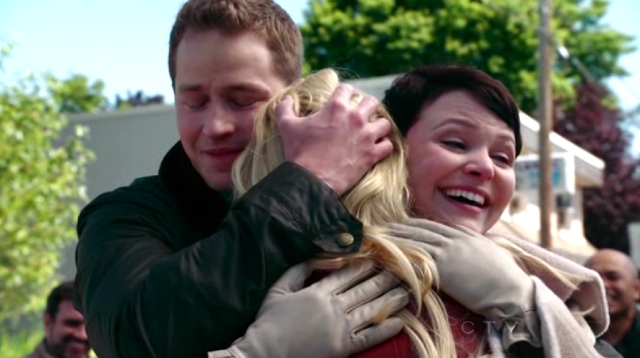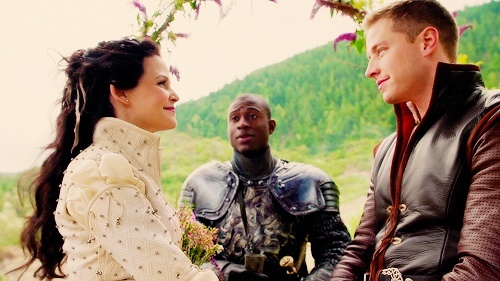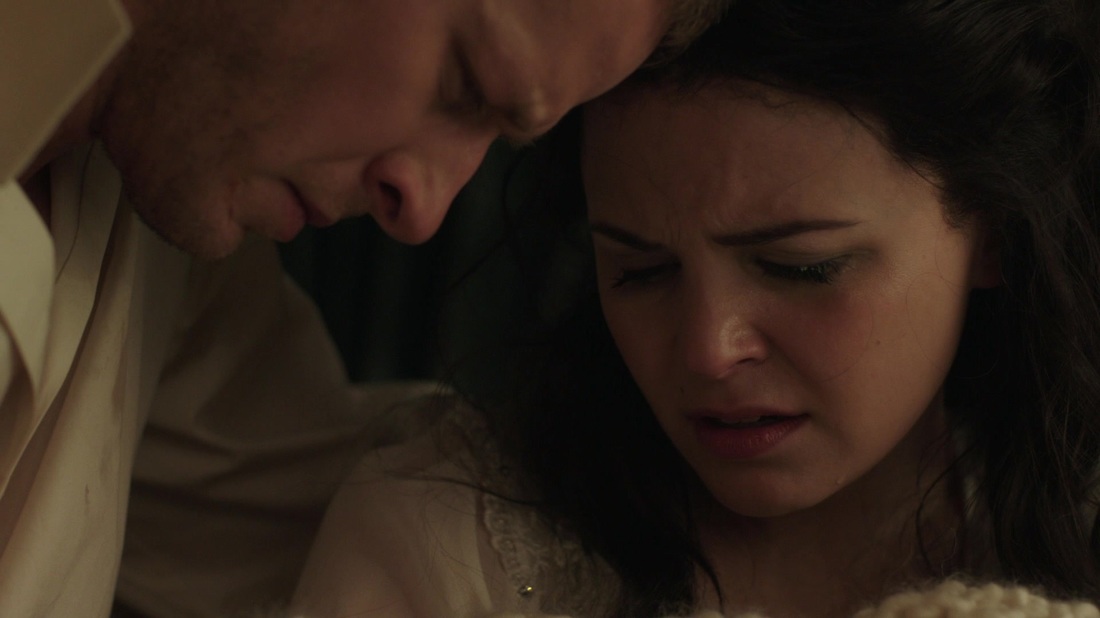|
Three: The Family of the Fairest of Them All and Her Charming by Teresa Martin--@Teresa__Martin October 14, 2012 It has been a little less than a year since I first saw Prince Charming in the most-awesome-prince-clothes ever, galloping on a brilliant horse to wake his true love, drop that dreamy single tear, and declare “I will always find you,” making my heart melt (and maybe Google the actor’s name, pledging to name my first-born after him, and perhaps buy a shot-glass with his silhouette on it). After that amazing first impression, I have since seen Charming fight off evil guards while holding a baby*sigh,* watched that single tear slide down his cheek numerous times *double sigh,* travelled with him as he went to hell and back with Snow, and proposed to her by a scenic lake *swoon.* This central couple, affectionately shipped as “Snowing,” also suffered a curse, and, as Mary Margaret, poor Snow had her heart torn in two, trampled on, and tossed into the trash (symbolically happily, unlike other unfortunate residents of Storybrooke). Yet she earned her happy ending at the end of Season One, embraced by her groom, as a spinning camera showed the completion of their story arc *squee!* Now I’m with my weekly Once Upon A Time viewing group, with a laptop to monitor the tweets, and checking on the Once Upon a Fan website, whose staff I joined as a writer, inspired by Once Upon A Time to delve back into non-fiction after a ten-year break. Next to me lies a half-finished Baby Emma Blanket, but I eventually give all attention to the screen as I follow the S2x3 adventures of Lancelot with Snow and Charming. I watch as Snow travels to meet Charming’s mother just in time to see her pierced by an arrow—goodness these writers sure are hard on their characters-- and seek magic waters to cure her. Ruth, Charming’s mother, drinks, but is not cured. What’s up with that? Ruth then expresses regrets that she will not see Snow and Charming’s wedding. Snow assures her that she will. What? Snow asks if Lancelot can perform the wedding. What? Next thing I know The Fairest of Them All is getting married under a perfect arch that must have been tucked away somewhere with a magical “instant-wedding-canopy” spell, and a chalice representing the Holy Grail is presented. This leads to the perplexing mystery of what else Lancelot has in his Knights of the Round Table Kit. I write. Season One gave us a Snowing arc centered on True Love, telling their Enchanted Forest and Storybrooke stories of falling in love, being separated, and finally reunited. Snow White had been given the beautiful engagement ring by Charming in the Season One finale, promising marriage, and the present-day Snow and Charming had a dramatic reawakening of their memories and kissed for the first time in Storybrooke as husband and wife. Almost forgotten as a participant in this marriage Season One was the third member of the family: grown-up Emma. This was remedied during the moving Charming Family Reunion in the Season Two premier. The parents and their daughter embraced in a triform, bringing the number three to mind. Three according to Aristotle is “. . . the number of the whole, inasmuch as it contains a beginning, a middle and an end.” Spiritually the number three is used universally in religion. From the African Ashanti, to pre-Islam Arabic cultures, Buddhism, ancient Celtic beliefs, Christianity, and Taoism, three is embedded in the practitioner’s deities or beliefs. Moreover, also correlated with three, the triangle is “the aspiration of all things toward the higher unity (Cirlot 351).” In ancient times this shape was foundational in mathematics as a discipline and a philosophy. The Greek Mathematician and Philosopher Pythagoras saw the triangle as a “sign of wisdom, linked with [the goddess] Athena (Tressider 4408).” Then, in the Twentieth Century, a discovery was made that was nothing short of miraculous: the atom, the building block of all life, is made of three parts. Three is strength, eternity, and gives foundation to all else in the world (Cirlot 232). In Season Two, the first episode that centered on the Charming family was—coincidence? –- the third. Emma haunted the episode throughout, even though she had yet to be conceived. Charming planned to introduce Snow to his mother. Snow arrived, only in time to see her fatally wounded. As the would-be mother-and-daughter-in-law bond, the discussion turned to babies. Ruth wanted to give Snow an heirloom necklace which can determine the gender of a child. Snow’s expression gave away the secret that she had been cursed with loss of fertility. One of the symbols of the number three, childbirth, had hence been removed from the future family. Indeed the show used rather strong language by describing this as a curse. Bravely the writers had drifted into the oft-taboo subject of the grief one feels in being unable to bear children. Even though adoption is a marvelous gift, as seen through Regina’s love for Henry and their renewed mother-son relationship, nevertheless there is still a certain sorrow. Ruth recognized this and therefore sacrificed her own cure in favor of Snow’s. Despite the yelling at televisions reverberating around the world advising that all Snow needed was a dose of True Love’s Kiss chez Charming, Ruth completed her plan, sacrificing her life for Snow and Charming’s future child. When a quick wedding was suggested, Charming, Snow, and Lancelot formed in a triangular pattern. Lancelot then held out a chalice and spoke of the legend which all recognize as the Holy Grail from Arthurian legend, the chalice from which Jesus allegedly drank at the Last Supper. This chalice, still used in traditional Christianity, is often depicted in art as the Trinity—One God in Three Persons. Snowing, the two, become one in their wedding, and later become three when they conceive Emma. This daughter hence is the product of True Love, and embedded within her is a powerful, pure magic of which even Rumplestiltskin is in awe. The writers therefore have explicitly informed the audience that Emma’s power is inseparable from the love of her parents, not merely the result of a prophecy. Rumplestiltskin revealed this fittingly in S2x9. Nine as the product of three multiplied by three is considered the ultimate number for perfection. Or perhaps these numberings are merely coincidences. Perhaps. Three is also a symbol for “biological synthesis, childbirth, and the solution of a conflict (Cirlot 235).” Or it could be the spiritual, actual, and inescapable symbol for the Charming Family established by the pilot episode. In a pivotal moment Regina interrupted the royal wedding to announce a curse that would permeate the first season. The pilot then skipped months later to show that Snow was pregnant. Her hand rubbed over her stomach, just in case the point was missed. From that moment on, there has not been a plot, struggle, or victory without these characters’ interactions. Emma even played a role in the scene at Rumplestiltskin’s cell in which he was fascinated with Snow’s swollen stomach. Moreover, when this family was separated as the curse approached, everything was off. How off was shown by Snow’s wail of anguish after Charming takes Baby Emma to the wardrobe. This is symbolic of the horrible power of that triad being broken apart. A nuclear bomb occurs when an atom is split; spiritually this scene presents the equivalent. Nothing will ever be right until they are reunited. When I viewed “Broken” in September, I recall being moved by the Charming Family reunion and being pleasantly shocked when, as they hugged, the music played was not a new motif, rather it was the “Snowing Theme.” For the first time, this melody was not reserved for a romantic moment between the parents, but rather was for the family. The marital love between the Fairest of Them All and Her Charming is inseparable from the fruit of their union. So now I sit, a few months later, after gathering a source here, reading a work there, and have finally put it all to paper. When the new episodes are broadcast in the New Year, I anticipate more signs of the number three, that is until an episode airs in which Henry is prominent and all I see is the number four appearing everywhere. Now four is the symbol of . . . . Works Cited
Cirlot, J.E. A Dictionary of Symbols, Second Edition. Taylor and Francis e-Library, 2001. Cooper, J.C. An Illustrated Encyclopedia of Traditional Symbolism. “Numbers.” London: Thames and Hudson, Ltd, 1978. Print.
0 Comments
Leave a Reply. |
OriginsExplore the Arthurian legend surrounding Lancelot, take a trip into the woods to discover the mythology behind Red Riding Hood or learn more about a modern day hero called Snow White. Origins provides unique insights and perspectives from talented writers into the characters we know and love, going far beyond the boundaries of Storybrooke. Archives
August 2016
Categories
All
|



